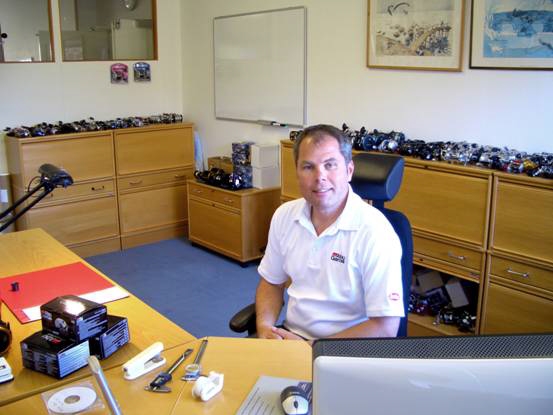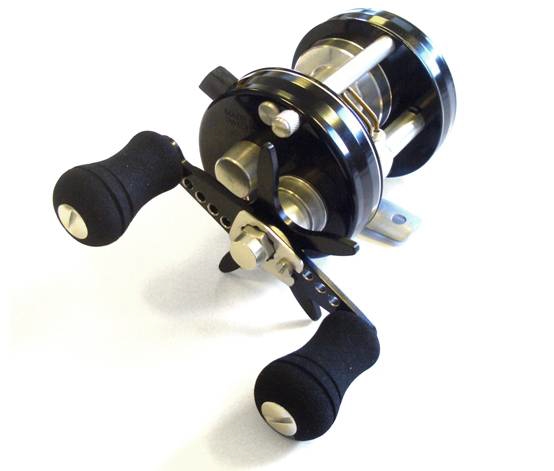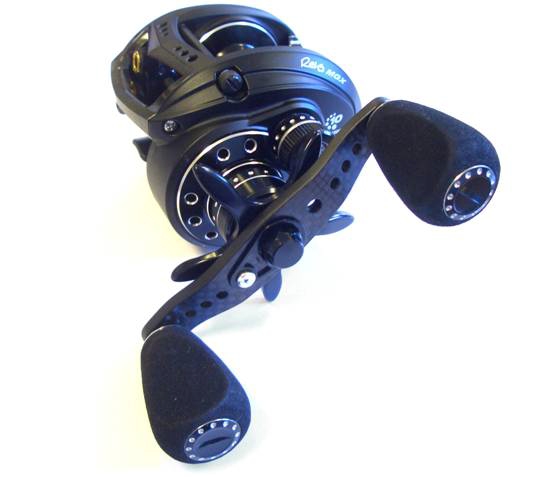Significant ABU Friends
(A Brief Conversation with Patrik Svensson from Pure Fishing Svangsta)
Meeting a Maker

Patrik Svensson’s office is just like any other big office. Except for the hundreds of fishing reels scattered across shelves and desks and window sills. His office is located on the top floor of the ABU Factory in Svängsta, Sweden. His Pure Fishing business card reads “Global Director Conventional Reels.” That sounds like an okay job. How did he get there?
“I started at the ABU Factory in 1984, when I was 18 years old. My first job was in the Print Department, which attaches letters and numbers and such to the reels. Then I moved to machining, then assembly, and then quality control. In 1992, I moved to Product Development, and was appointed head of that department in 2000. Four years ago, the Jarden Corporation purchased Pure Fishing, which added development of Shakespeare and Pflueger reels to my responsibilities. And since last year, I have also had Penn.”
Imagine my surprise: I thought I was talking to a 100-percent ABU man. Welcome to the modern world. Of course, Shakespeare, Pflueger, and (to a much lesser extent) Penn used to be competitors of ABU. So I have to ask whether overall responsibility for all these different brands doesn’t generate a certain degree of schizophrenia?
“A little. But we focus on the big picture and the role that different brands can play in different market segments. Penn makes saltwater reels and Shakespeare mostly caters to the economy segment of the market. ABU and Pflueger are more alike but there is a greater emphasis on low-profile reels in the Pflueger lineup.”
Svensson fishes out a Shakespeare E-Z Cast from the ocean of reels in his office; a beginners’ reel with a simple but effective anti-backlash mechanism and a sub-$40 price tag that combined to make it a success. Where do new ideas come from?
“They say that a problem is a good start to a solution. It could be the requirements implied by new rods, new lines, new fishing techniques, or a any combination of these. To be successful, a new idea has to be integrated into an overall package – the whole reel has to work, not just the individual idea. And although you and I might love all sorts of complicated gimmicks, when you are in the business of producing fishing reels, you have to weigh costs of production against potential market demand.”

On the table between us sits an Ambassadeur 2500C that weighs just 149 grams, a supremely elegant version of my favourite reel. Unfortunately, it is likely to remain the only example – a casualty of someone’s projected benefit-cost ratio. Does Svensson ever think of agents, accountants, and marketing departments as enemies rather than friends?
“No.”
He does, however, admit that it’s sometimes hard to explain why an innovation fails. In the late 1980s, ABU developed the “Syncro” drag for Ambassadeurs, which allows the angler to adjust drag pressure by moving the crank backwards or forwards when line is paid out. According to Svensson, it’s a wonderful feature, and he often uses Syncro reels when he engages in his favourite pastime – trolling for salmon. The Syncro drag was applied to a whole range of ABU reels, but never caught on.
Svensson has been around this business for a while. What, in his view, are the most important changes in casting reels since he joined ABU in 1984?
“The feel, the smoothness of the mechanisms. As far as Ambassadeurs are concerned, it’s simply the gears. By the early 1990s, ABU had fallen behind. We took the gears from our main competitors and put them into our reels and were shocked by the difference. We invested heavily, and by the mid-1990s, our gears were competitive again. Generally speaking, drag washers and drags have improved a lot over the years. But you have to see reel development in the context of tackle evolution more generally. For example, rods are lighter and more sensitive today so reels must follow suit. Lines are much stronger now so small reels have to be much stronger and more durable than they were before.”
The future, according to Svensson, will bring more of the same: reels that are stronger, lighter, and also faster. He shows me the new Ambassadeur Revo MGX, a low-profile reel, with a magnesium frame, that weighs 154 grams and has a 7.9:1 gear ratio. Strictly for the American and Japanese markets as yet, but due to be introduced in Europe next year.

What about new materials?
“Titanium is overrated. It has good corrosion properties but is a substitute for steel, not aluminium. And despite the hype, reels made mostly from titanium are heavier, not lighter, than aluminium reels.”
Magnesium and carbon fibre hold much more promise according to Svensson.
And while nanotechnology has been around for some time now – for example in Orvis rods and (to a very modest extent) in some of the new ABU fixed-spool reels – Svensson believes the balance between cost and performance is not yet right for use in conventional reels. But its time will come.
And digital control? Will we see computer chips inside ABU reels?
“It’s not in our plans. We did some experiments with the concept in the 1980s but nothing came of it. And now, I suppose, it’s a case of ‘been there, tried doing that’.”
So what’s ABU’s greatest asset?
“ABU’s biggest advantage is our service policy and service performance, with quick access to spare parts. Another big advantage is our reputation. Anglers still possess a fundamental belief in the ABU brand, and this allows us to be bold, to take chances that most others don’t feel they can afford.”
ABU’s weaknesses?
“Right now, there are none. But after I became head of Product Development in 2000, I spent the next four years putting out fires. Tolerances that needed to be lowered, lots of small details that needed to be fixed.”
And if Svensson had to pick an “im-Pure-Fishing reel” for his salmon trolling?
“It would be a .......... Of course we use our competitors’ reels all the time, it’s part of the job.”
These would appear to be tough times for the Ambassadeur and other Pure Fishing baitcasters. About half as many reels are sold world-wide these days as were sold in the mid-1980s. To this woeful fact, we can add the avalanche of cheap reels from South-East Asia and the ever-increasing popularity of fixed-spool reels. There’s a slight pause here as we ponder these developments, the way two monks might contemplate the signs and symbols of some strange, incomprehensible religion. But things are not too bleak. Says Svensson:
“It’s a flat market. Flat but not declining. We’re competing for shares. And we’re holding our own.”
© Espen Sjaastad, 2011
If you are a person that has significantly had an effect on design/development/testing/collecting of ABU equipment over the years please contact me wayne@realsreels.com if you wish your contribution documented for posterity and the immediate interest of the ABU fans worldwide!